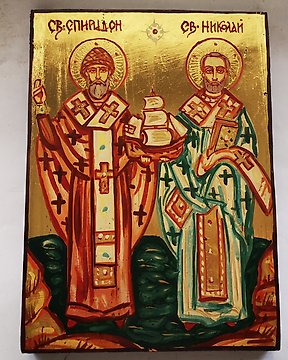
Ikona - Św. Mikołaja Cudotwórcy i św. Spiridona - Drewno
Nr 84238759

Nr 84238759

Icon of the Archangel Michael and Jesus Christ - Not made by hand.
The icon is in good condition.
Ubrus (in Greek μανδύλιον) or "Image not made by hands" (in Greek Αχειροποίητος- not made by hands) is an iconographic image of Christ in which only the head of the Son of God is represented on cloth.
According to the legend told by the church historian Eusebius of Caesarea, the ruler of the Asia Minor city of Edessa (now Ufa, Turkey) Avgar was sick with leprosy. He asked his court painter Ananias to bring him an image of Jesus Christ, about whose miraculous healing powers he had heard so much. Ananias finds Jesus preaching and tries to paint him, but "he cannot understand the image of God." After the sermon, Christ washed his face and wiped it with a linen cloth (towel), which he then gave to the artist. The image of the Son of God was printed on it - "Image not made by hands". This image is said to be the first supernaturally created icon.
Ananias took her to Abgar and when he kissed her he was cured of leprosy. The non-manmade icon was glued to a board and placed over the city gate of Edessa. In 545, the Persian Shah Khorsoi besieged the city. By this time the cloth was soiled and forgotten. The bishop of Edessa receives a revelation that the city will be saved if the image of God is revealed. When the plaster was removed, the canvas with the image of the face of Jesus (Ubrus) and the negative impression of it in the clay plaster - Keramidion (Keramida) were discovered. After the victory over Khorsoy, the two images became the greatest asset for the city. In the "Chronicle" of Michael the Syrian, it is said that in the 6th century the aristocrat Athanasius commissioned an artist to repaint Ubrus. The resulting copy fully corresponded to the original. In 944, the Byzantine emperors Constantine VII the Red-headed and Romanus I Lacapinus besieged Edessa and demanded that Ubrus be handed over to them for a ransom. The unfinished image was solemnly transported to the capital of Byzantium. It is kept in the Church of Saint Sophia. After the fall of Constantinople to the Crusaders in 1204, the original image disappeared.
The icon is in good condition.
Hand painted on wood.
Jak kupować w serwisie Catawiki
1. Odkryj coś wyjątkowego
2. Złóż najwyższą ofertę
3. Dokonaj bezpiecznej płatności